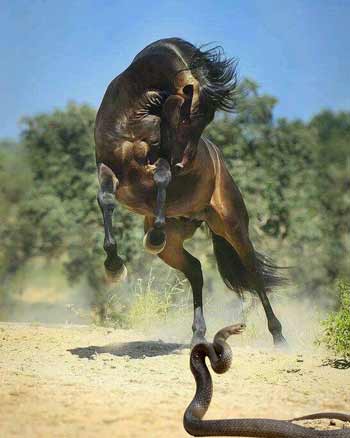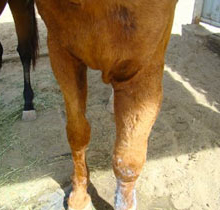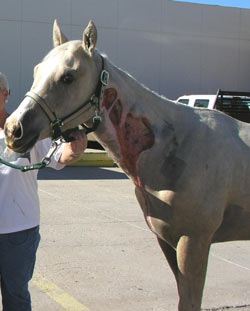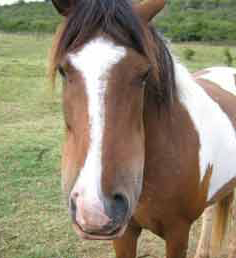
|
One of the reasons horses die from snakebite is the delay in recognition and treatment.
Treatment is aimed at both correcting the effects of envenomation and supporting the horse while it recovers. |
|
While snakes are around all year, once the warmer weather and dryer conditions arrive is when we see them, and the incident of pets being bitter increases. Australia has the highest number of venomous snakes, however we have very low numbers of snake bites each year and even fewer human fatalities.
There are no reliable figures on how many horses each year die of snake bite so the incidence is unknown. However, most equine Vets will see one or two suspected snake bites each year and know a couple of horses that die of suspected snake bite.
As the weather continues to warm-up, the Australian Veterinary Association (AVA) is encouraging animal owners to take precautions to help minimise the risk of snake bites in pets and seek immediate veterinary advice if they suspect their animal has been bitten.
AVA president, Dr Paula Parker, said that snakes tend to be their most active at the end of the day.
Snakes are often looking for rats and mice to eat and where better to look than in the feed sheds and hay storage areas of equestrian properties. Keeping your stable area and horse yards free of long grasses, piles of timber, old rugs, feed bags and rubbish may not stop the snakes but it will mean that you have more of a chance of seeing them before they cause problems for your animals.
“Snake bites often occur in the late afternoon or early evening, however it’s important for people to be vigilant throughout the day,” she said.
“Outside, keep a close eye out for snakes in bushy areas or near water,” Dr Parker continued. “It’s best to try and keep horses, cattle and sheep away from bushy areas. Dog owners should try and avoid these areas when walking their pets at the end of the day and preferably keep them on the lead.”
The AVA said it’s important for animal owners to be aware of the signs of a snake bite as they may not actually see their animal being bitten. Signs of snake bite can vary depending on the snake and the location in Australia. Common signs of a snake bite include:
- Sudden weakness followed by collapse
- Unexplained bleeding or swelling
- Reluctance or inability to walk
- Breathing problems.
Bites from some snakes will cause an animal to collapse, and then seem to recover. This can give false confidence that the animal is okay, but what is really happening is the snake toxins are spreading through the system and wreaking havoc. Within a few hours, other signs start to develop.
“If you think your animal has been bitten, keep your pet calm and contact your vet immediately. The chances of recovery are much greater if treatment is delivered early,” Dr Parker said.
Based on a media release sourced from the AVA website.
IHow badly the horse is affected depends on where the horse was bitten, how much venom has been deposited into their system, how quickly it is circulated and whether you noticed it in time or not. One of the reasons horses die from snakebite is the delay in recognition and treatment. Treatment is aimed at both correcting the effects of envenomation and supporting the horse while it recovers.
f your horse recovers from snake bite it may take weeks or months for him to recover fully. You may notice that he loses a lot of muscle mass post envenomation and has swelling problems of the legs due to the damage to the muscle and kidney cells. Consult an equine nutrition expert to help design a feed regime that supports muscle development, blood and kidney function recovery.
Bring back in to work slowly and build up muscle and stamina as tolerated.
Based on a media release sourced from the AVA website and Care Equine Clinic report.
| |
|
|
|
|
 |
|
 |
 |
|
| Various snake bites and how they affected the horses. |
|
|
|
|
SNAKE FACTS
There are 3 main types of brown snakes – Eastern, Western and King Browns. They live all over Australia. Eastern browns tend to be more aggressive than the others and King Browns have the most venom per bite – up to 150gms compared to around 40gms from other species. More people are bitten by browns due to their higher prevalence.
Tiger snakes have less venom but they are more aggressive and so if they do bite they often bite more than once.
Taipans have highly concentrated venom and really long fangs which is why these were considered fatal bites in the past. They are really shy though and tend to flee rather than strike.
Red bellied blacks are both shy and not very aggressive with small amounts of venom so serious bites are rare from these guys.
Identifying the type of snake that bites your horse may help the vet in the treatment regime.
Identification is not as clear cut as it seems. If snakes are shedding their skin (as they do each year) it can be hard to tell what type they are. Definitive identification is made by snake experts who use a range of techniques such as counting the number of scales per square inch.